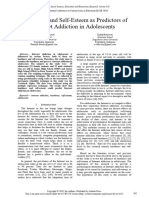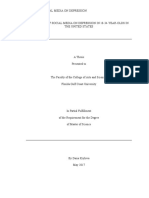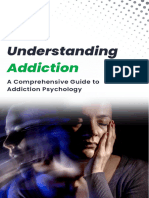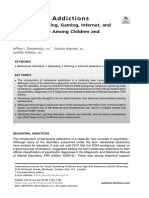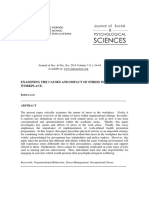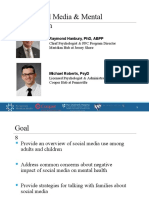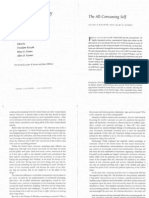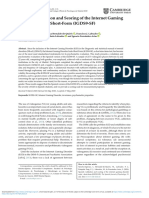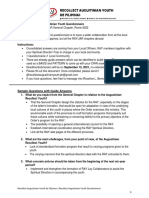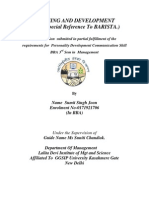Index
Sr. No. Chapter Page No.
1 Introduction 3
2 ADDICTION AND TECHNOLOGY 4
3 CAUSE OF TECHNOLOGY 5-6
4 CONSEQUENCES OF TECHNOLOGY 7
ADDICTION
5 THE SIGNS OF A TECHNOLOGY 8
ADDICTION
6 THE MOSTCOMMON TYPES OF 9-10
TECHNOLOGY ADDITION
7 THE TREATMENT FOR A TECHNOLOGY 11
ADDITION
8 CONCLUSION 12
2 2 of 13
� Introduction
Due to the many problems they cause, addictions are one of the most frequently discussed issues in the
literature. Addiction is the inability to stop using a substance or behavior despite its psychological and
physical harms (Luigjes et al., 2019:9). Therefore, addicted people often use substances or engage in
behaviors that persist and become compulsive, despite their harmful consequences (Lüscher et al.,
2020:247). Described as chronic disorders (Dennis & Scott, 2007:49), addictions can seriously affect the
course of daily life over time. Addictions can not only affect the addicted people itself but also harm their
social environments. Anxiety, stress, depression, negative mental health, and permanent health
complications are some of the prominent consequences (Akın & İskender, 2011:142). Neglecting social life
and family, distancing from sociality, and inability to focus on the environment are among the social
problems (Turel et al., 2011:90). There are many different types of addictions. They include the use of
substances such as alcohol, drugs, cocaine, nicotine, and coffee (Kendler et al., 2007:1315) and behaviors
such as gambling, sex and excessive use of technology (Amudhan et al., 2021:3). Technology addiction,
which is the subject of the present study, in particular, is one of the prominent issues in the addiction
literature with the spread use of technology
3 3 of 13
� Addictions and technology addiction Addiction
It is defined by the APA (American Psychological Association) as a chronic disorder with biological,
psychological, social, and environmental factors that affect its development and maintenance. Considering
in more detail, it can be stated that addiction is a multifaceted situation arising from the combination of
many elements. These elements include genetic, physiological, gender, psychological, trauma and abuse,
family, peers, accessibility, and employment status (Belcher & Shinitzky, 1998 ; Cuomo et al., 2009; Parvizy
et al., 2005). Almost all addictions affect the individual and the environment negatively. Social isolation,
loneliness, depression, stress, anxiety, and conflict are just some of them. Addicted people can spend all
their resources to seize the substance, especially in substance deprivation. The psychology of the addicts
whose resources have expired deteriorates and there may be attempts to obtain the resources of their
close circle by force. The most notable among addictions is substance abuse. Among these, there are those
with severe consequences such as drugs, cocaine, and alcohol, as well as those with fewer problems with
food and coffee (Kendler et al., 2007: ). Of course, addiction does not only consist of material elements
(Chóliz at al., 2017:). In addition to material factors, there are also behavioral addictions such as sex,
gambling, gaming, and technology use which affect human life (Amudhan et al., 2021:; Hall, 2011; Griffiths,
1995:). In terms of consequences, although not as much as addictions caused by substance use, the harms
of behavioral addictions are also critical. One of the types of addiction that has become widespread and
continues to become widespread recently is technology addiction (Aagaard, 2021) Chen et al., 2021 Chóliz,
et al., 2017). Technology addiction has emerged as a result of increasing technology use and draws a
similar appearance to other types of addictions. Therefore, in recent years, there has been a growing
awareness that using technology every day is often impulsive and thoughtless and sometimes distracts
attention from other activities (Aagaard, 2021). The concept of technology addiction is characterized by
concepts such as preoccupation, mood change, and conflict. As in other types of addictions, individuals
become more prone to technology addiction (Griffiths & Wood, 2000), due to reasons such as easy access,
limited self-control, and increased peer pressure (Belcher & Shinitzky, 1998; Cuomo et al., 2009 Parvizy et
al., 2005). In addition to these factors, exposure to technology can be considered another important
antecedent. In terms of its consequences, technology addiction is similar to
4 4 of 13
� Causes of technology addiction
Since the scope of technology addiction is quite wide, factors causing technology addiction are also
quite large. Especially the developments in information technologies are the most basic macro issue that
causes the emergence of technology addictions (Chen et al., 2021:). On the other hand, there are also very
specific micro factors. Personality, mood, some negative habits, and environmental factors are some of
them. For instance, in a study, selfcontrol and the amount of time using media were found to be significantly
related to internet addiction (Khang et al., 2013). Similarly, sensation seeking, neuroticism, and
dysfunctional impulsivity positively affect internet addiction (Kuem & Ray, 2021). Xu et al. (2012) in their
research to identify the antecedents of game addiction, concluded that the need for mastering game
mechanics and the need for relationships increase addiction. In another study, hedonic motivation,
involvement, peer attachment, and trust were found to be causes of Facebook addiction (Nasr & Rached).
Seo & Ray (2019) drew attention to focused immersion and concern for social acceptance as causes of
addiction. One of the issues that can be associated with personality traits is emotional intelligence.
According to a study, those who are emotionally intelligent are less technology addicted (Hamissi et al.,
2013). On the other hand, dark personality traits seem to trigger addictions. For instance, highly narcissistic
people tend to be more active on Facebook or other social networking sites (Buffardi & Campbell, 2008).
Not only personality traits but also environmental factors have an impact on technology addiction. Positive
correlations were found between perceived broken neighborhood relations and widespread phone use, and
smartphone addiction (Herrero et al., 2021). In a study conducted on students, it was concluded that game
addiction, neglecting daily chores, and bad relationships with professors were significantly associated with
internet addiction (Baturay & Toker, 2019). According to an interesting finding of a study, spending the
weekend intensely increases social satisfaction and it triggers technology addiction (Li et al., 2017). As seen,
the previous study points to many factors that ca
use technology addiction. These factors range from simple mood to personality traits, from neighborhood
relationships to larger macro considerations. Of course, it is useful to address all the factors, but it seems
difficult to fit each of them into a single study. Table 1. Some causes of technology addiction Causes Type
of technology addiction Reference Advances in information technologies General technology addiction
Chen et al. (2021) Self-control The amount of time using media Internet addiction Khang et al. (2013)
Sensation seeking Neuroticism Dysfunctional impulsivity Internet addiction Kuem & Ray (2021) Needs for
mastering game mechanics Needs for relationship Game addiction Xu et al. (2012) Hedonic motivation
Involvement Peer attachment Trust Facebook addiction (Social networking sites addiction) Nasr & Rached
(2021) Focused immersion Concern for social acceptance Social networking sites addiction Seo & Ray
(2019) Low emotional intelligence General technology addiction Hamissi et al. (2013) Narcissistic
personality trait Facebook addiction Other social networking sites addiction Buffardi & Campbell (2008)
Poor neighborhood relations Smartphone addiction Herrero et al. (2021) Game addiction Neglecting daily
chores Poor relations with professors and friends Internet addiction Baturay & Toker (2019) Heavy weekend
General technology addiction Li et al. (2017 Table 1. Some causes of technology addiction Causes Type of
technology addiction Reference Advances in information technologies General technology addiction Chen
et al. (2021) Self-control The amount of time using media Internet addiction Khang et al. (2013) Sensation
seeking Neuroticism Dysfunctional impulsivity Internet addiction Kuem & Ray (2021) Needs for mastering
game mechanics Needs for relationship Game addiction Xu et al. (2012) Hedonic motivation Involvement
Peer attachment Trust Facebook addiction (Social networking sites addiction) Nasr & Rached (2021)
Focused immersion Concern for social acceptance Social networking sites addiction Seo & Ray (2019) Low
5 5 of 13
� emotional intelligence General technology addiction Hamissi et al. (2013) Narcissistic personality trait
Facebook addiction Other social networking sites addiction Buffardi & Campbell (2008) Poor neighborhood
relations Smartphone addiction Herrero et al. (2021) Game addiction Neglecting daily chores Poor relations
with professors and friends Internet addiction Baturay & Toker (2019) Heavy weekend General technology
addiction Li et al. (2017) Some causes of technology addiction Causes Type of technology addiction
Reference Advances in information technologies General technology addiction Chen et al. (2021) Self-
control The amount of time using media Internet addiction Khang et al. (2013) Sensation seeking
Neuroticism Dysfunctional impulsivity Internet addiction Kuem & Ray (2021) Needs for mastering game
mechanics Needs for relationship Game addiction Xu et al. (2012) Hedonic motivation Involvement Peer
attachment Trust Facebook addiction (Social networking sites addiction) Nasr & Rached (2021) Focused
immersion Concern for social acceptance Social networking sites addiction Seo & Ray (2019) Low
emotional intelligence General technology addiction Hamissi et al. (2013) Narcissistic personality trait
Facebook addiction Other social networking sites addiction Buffardi & Campbell (2008) Poor neighborhood
relations Smartphone addiction Herrero et al. (2021) Game addiction Neglecting daily chores Poor relations
with professors and friends Internet addiction Baturay & Toker (2019
6 6 of 13
� Consequences of technology addiction
The types of technological addictions that arise due to the widespread use of information processing
technologies often cause negative consequences. These emerging problems include psychological and health
problems, negative mood problems, social and family problems, and work problems. It is emphasized that
technology addiction creates mental health problems in modern societies (Chóliz et al., 2017; Brand et al.,
2014). Oberts et al. (2017) specify internet addiction amongst adolescents has become a serious public
health problem in some countries. In the emergence of such social problems, the possible effects of
addictions on individuals’ psychology could be the main reason. Because individuals with mental disorders
affect the society they live in. Studies indicate that excessive internet use causes psychological problems
(Barthakur & Sharma, 2012), and situations such as social phobia and hostile behaviors are caused by
excessive internet use (Ko et al., 2009:). According to Baturay & Toker (2019:), internet addiction decreases
one's self-esteem, self-confidence, social self-efficacy, academic self-efficacy, and triggers loneliness. Other
consequences of internet addiction include social anxiety (Wartberg et al., 2015), depression (Liang et al.,
2016), attention deficit (Wang et al., 2017), poor academic performance (Kumar et al., 2018), and stress (Jun
& Choi, 2015). Technology addiction is not limited to internet addiction. Addiction to social networking
sites also has serious harmful consequences. For instance, social networking sites can negatively impact
addicts' mental health (Bányai et al., 2017). According to Moqbel & Kock (2018:), addiction to social
networking sites reduces positive emotions which increase performance and improve health. As a result,
attention deficit increases, and performance decreases in individuals (Moqbel & Kock, 2018). The
consequences of technology addiction are also related to social and business life. According to a study,
excessive use of mobile social networking sites leads to three types of conflicts (tech-personal, tech-family,
and tech-work) and increases perceived mobile technology stress (Zheng & Lee, 2016). Findings show that
negative life experiences, poor health, and poor performance are linked to social network use (Fox &
Moreland, 2015:). Even at a micro level, the consequences of addiction are visible. For instance, even
mobile e-mail addiction causes technology-family conflict, work overload, work-family conflict, and
reduced organizational commitment (Turel et al., 2011)
7 7 of 13
� THE SIGNS OF A TECHNOLOGY
The United States there is currently no clinical diagnosis for technology addiction, and it is not mentioned in
the Diagnostic and Statistical manual of Mental Disorders 5 th Edition (DSM-V). The closest such diagnosis
classified by the American Psychiatric Association is Internet Gambling Disorder, a subset of Gambling
Disorder. Internet addiction has however been formally recognized by the American Psychological
Association, and countries such as China and South Korea in addition to the World Health Organization
have recognized Internet addiction as a significant threat to public health.
Despite lack of consensus on diagnostical criteria for digital addictions there are various studies that provide
practical considerations of signs and symptoms of digital addictions. Although spending excessive amounts
of time on digital devices can be a sign of a technology addiction, frequency and duration of time spent on
digital devices in and of itself does not necessarily denote a technological addiction. More importantly a
technological addiction is apparent if and when digital usage interferes with one’s daily life and general
wellbeing, and if the individual as a preoccupation with using their digital medium of choice.
Some signs of a technology addiction include:
Inability to moderate or abstain from technology or a. specific digital medium .Preoccupation with thinking
about using technological devices. Compulsive technological use or experiencing cravings and urges to use
digital devices .Neglecting important life areas such as work, school or relationships at the expense of
technology. Continuing to use digital devices despite it contributing to consequences in your life . Losing
interest in social and leisure activities that you once enjoyed at the expense of technolog y.Using digital
devices in dangerous situations such as while driving a car or walking across a city street. Experiencing
unwanted mental health symptoms such as depression, anxiety, stress or irritability at the expense of
technological usage.Using digital devices to induce pleasure or experience
gratification. Lying or hiding digital usage from family, friends or colleagues as a result of guilt or shame.
Using digital devices for longer durations than intended or finding yourself using digital devices with
increased frequency over time
8 8 of 13
� The Most Common Types of Technology
Gaming Addiction
Gaming Addiction
Gaming has become more popular than ever before and are available not only on consoles and
computers but also right on your phone. Some of today’s most popular games include Fortnite, World of
Warcraft, League of Legends, PlayerUnknown’s Battlegrounds, Roblox and several others. Part of what
makes gaming so addictive are built in rewards, hidden features, and side quests. Every time an
individual completes a level, beats a boss, kills an opponent, or unlocks a new player or level the
individual receives a boost of dopamine, resulting in gaming-induced pleasure. Some games are never
ending. Socially interactive games such as eSports have also become increasingly popular. Such games
may be more socially engaging than one-player games but can also lead to a false sense of social
interaction. Gaming can also be compounded with gambling (example: eSports betting) and lead to a
dual addiction of both gaming and gambling.
Social Media Addiction
Social media platforms such as TikTok, Instagram, Twitter, Facebook, Snapchat and others are highly
addictive, and YouTube can also be grouped into this category. Every time an individual receives
engagement via a “like,” “follow” or “comment” the individual’s brain releases feel-good
neurotransmitters, ultimately resulting in wanting more engagement. Social media, like social gaming,
can invoke a false sense of social engagement leaving individuals feeling isolated and alone. Endless
scrolling of social media feeds, constantly refreshing feeds or binge watching TikTok or YouTube
videos also serve as a way to fend of loneliness, fight off boredom and fill other psychological voids.
Doomscrolling and a fear of missing out also play a large part in social media addiction. It is also
important to note that social media addictions that involve vanity such as posting selifes, using filters,
and a hyperfocus on physical appearance of self or others can transcend into other disorders such as
body dysmorphia disorder or plastic surgery addiction and other ways of altering one’s physical
appearance.
Online Gambling Addiction
While Gambling Disorder is a diagnostic addiction unto itself, it is important to recognize and treat the
pathological digital usage in tandem with pathological gambling when gambling is done virtually.
Online gambling includes but is not limited to online casino games, online poker, online sports betting,
eSports gambling, day trading, and cryptocurrency trading. As previously mentioned, Internet Gambling
Disorder is recognized by the American Psychiatric Association as a diagnosable mental health disorder.
Of all the various forms of addictions, including substance use addictions, gambling addiction has the
highest rates of suicide. As such, it is imperative to address problem gambling as soon as issues arise.
9 9 of 13
� Online Shopping Addiction
An online shopping addiction, also known as compulsive buying disorder, is a behavioral addiction that
involves impulsive and compulsive buying of good and services online. Online shopping addictions
often serve as a temporary way to induce pleasure and feel good, and as a way of avoiding negative
emotions and evading boredom. Online shopping is not only about the purchasing in and of itself, but is
also about the excitement of browsing prior to the purchase.
Work-Related Digital Addiction
Individuals who are addicted to their work are often praised for being hard workers, and while there is
great admiration for good work ethic, problems can arise when individuals become dependent on their
work. The work becomes a means of escape, and relationships, mental health, and general wellbeing can
suffer. While work addiction is different from digital addiction, there are often technological problems
associated with work addiction, especially for those in executive level positions or others who do office-
related work. For example, being tethered to your email, especially late at night or during other non-
work hours, on weekends or holidays can be extremely problematic, resulting in problems connecting
with family, increased stress, and other problems relating to psychological and general wellbeing.
10 10 of 13
� The Treatment for a Technology Addiction
The first step of treating a digital addiction is the individual’s awareness of the problem, and a desire to want
to get help. This is often the most challenging step for the individual. Oftentimes the problem is realized by
family and friends who may seek out help on behalf of the individual. In many cases an intervention is
needed in order to assist the individual into recognition of the problem and help them initiate treatment. If
the individual is motivated the issue can resolve itself with self-corrective behaviors, screen-life balance, and
assistance from technological innovations that help with digital moderation such as by enabling app
restrictions or WiFi restrictions, turning off notifications, enabling “Do Not Disturb” mode, setting up
automatic email/text responses, enabling automatic downtime, blocking apps or websites, using screen time
reports, and other such innovations that can help curb digital use. Some common modalities of treatment
for digital addiction include Motivational Interviewing, Cognitive Behavioral Therapy (CBT),
Dialectical Behavioral Therapy (DBT), Reality Therapy (RT), Acceptance and Commitment
Therapy (ACT), experiential adventure based therapy, mindfulness based relapse prevention, and
behavioral modification. Therapy may be carried out as individual therapy, family therapy, group
therapy or a combination of the three using a multimodal treatment approach. Pharmacological
interventions may also be used to address underlying mental health issues. Holistic and wellness-
based treatments are often encouraged focusing on meditation, nutrition, physical exercise,
nature, and other natural remedies. Although there are inpatient residential treatment options
available for digital addictions, treatment is generally done on an outpatient basis.
11 11 of 13
� Conclusion
In this study, the scope, types, causes, and consequences of technology addiction were examined with a
conceptual and descriptive intent. When general addiction and technology addiction are compared,
similar causes and consequences are observed. However, at this point, it can be stated that the
consequences of addictions created by Alcohol and substance use are more destructive than technology
addiction. This is the most important point where Technology addiction differs from other addictions.
Due to the integration of gambling and games with technologBehavioral addictions such as gambling
and gaming have also increased recently behavior trigger each other. There are also efforts of researchers
in the literature on what the concept is. Studies suggest that addiction criteria can be used to explain
technology addiction (Chóliz et al.). However, since technology addiction does not have a clear
parameter, there is still a need for new studies on this subject. General factors that cause technology
addiction are personality, personality traits, mood, and environmental factors. In addition to this, it is
seen that neighborly relations and past activities (heavy weekends) also affect technology addiction. In
this respect, it can be argued that technology addiction is affected by many factors, from macro to micro.
Considering all factors, it is possible to say that personality traits and relations with the environment are
among the main causes of technology addiction. Sensation seeking, neuroticism, dysfunctional
impulsivity, poor relations with others, narcissistic personality traits, relationship needs, and emotional
intelligence are the most frequently mentioned ones (Kuem & Ray, 2021; Baturay & Toker, 2019;
Hamissi et al., Buffardi & Campbell, 2008). In terms of consequences, mental health, psychological
states, conflict, and attention deficit are the most prominent ones The scope of technology addiction is
quite wide and includes various types of addiction-related to technology. These include internet
addiction, social networking site addiction, mobile e-mail addiction, game addiction, and smartphone
addiction . One of the striking details in the studies examined is that internet addiction and addiction to
social networking sites, which are among the types of technology addiction, are intensely mentioned.
Thus, it can be deduced that internet and social networking site addictions are more effective in terms of
their consequences and therefore they are frequently discussed by researchers as a subject of in their
studies. Present study has several implications for literature and practice. The findings of the study
reveal that the causes of technology addiction are mostly based on psychological factors. This shows that
it is important to question the psychological backgrounds of technology addicts in detail, as in other
addictions. The factors affecting technology addiction are not only related to personality and
psychological processes. In addition, environmental factors also seem to be important. Although studies
on environmental factors are limited in the literature, it is obvious that the issue is quite significant. As
internet-based transactions increase day by day, the use of technology also increases. This situation
naturally causes an increase in technology addictions. In this context, more effort, information and
therapy-like programs for addicts are needed more frequently in near future
12 12 of 13








